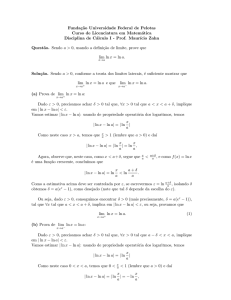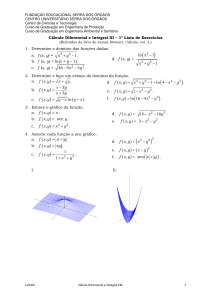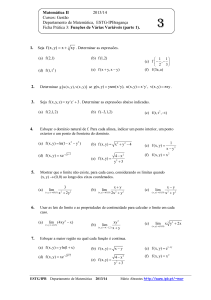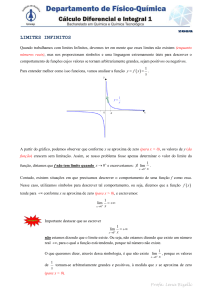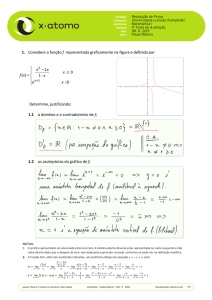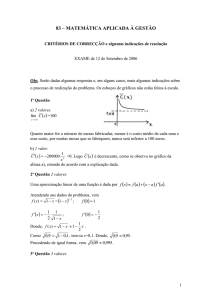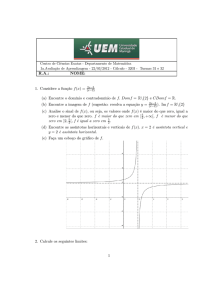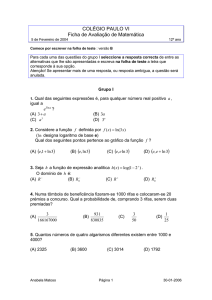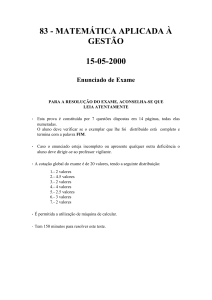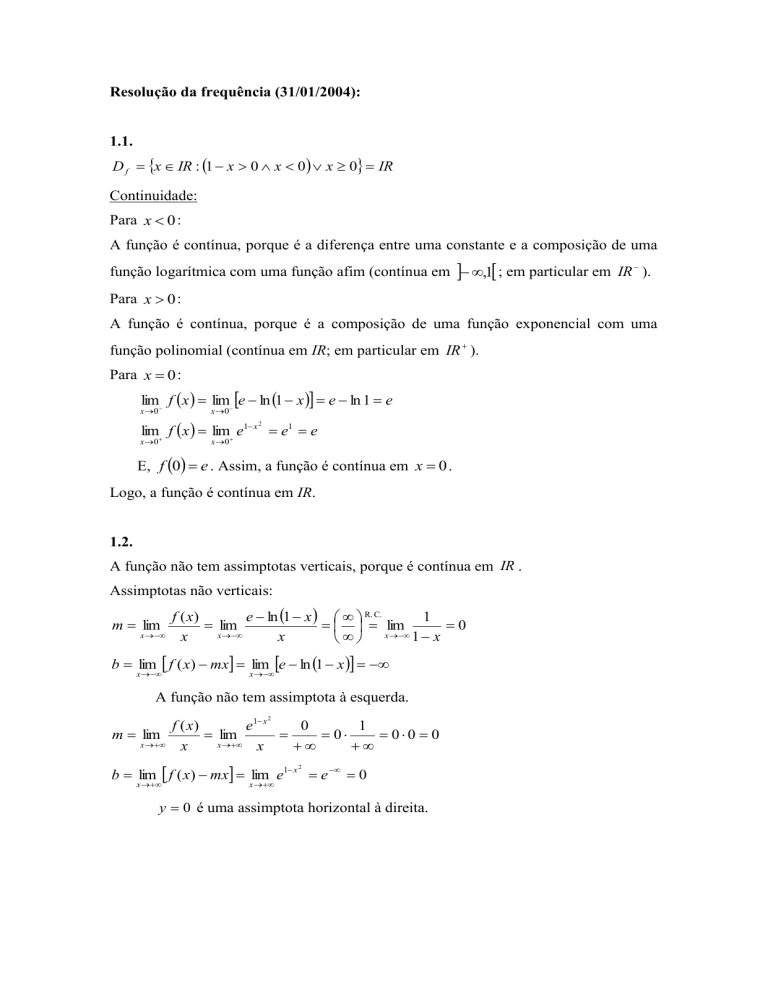
Resolução da frequência (31/01/2004):
1.1.
D f x IR : 1 x 0 x 0 x 0 IR
Continuidade:
Para x 0 :
A função é contínua, porque é a diferença entre uma constante e a composição de uma
função logarítmica com uma função afim (contínua em ,1 ; em particular em IR ).
Para x 0 :
A função é contínua, porque é a composição de uma função exponencial com uma
função polinomial (contínua em IR; em particular em IR ).
Para x 0 :
lim f x lim e ln 1 x e ln 1 e
x 0
x 0
lim f x lim e1 x e1 e
2
x 0
x 0
E, f 0 e . Assim, a função é contínua em x 0 .
Logo, a função é contínua em IR.
1.2.
A função não tem assimptotas verticais, porque é contínua em IR .
Assimptotas não verticais:
m lim
x
f ( x)
e ln 1 x R. C.
1
lim
lim
0
x
x
x
x 1 x
b lim f ( x) mx lim e ln 1 x
x
x
A função não tem assimptota à esquerda.
f ( x)
e1 x
0
1
m lim
lim
0
00 0
x
x
x
x
2
b lim f ( x) mx lim e1 x e 0
2
x
x
y 0 é uma assimptota horizontal à direita.
1.3.
Se x 0 :
f ' x
Se x 0 :
f ' x 2 xe1 x
1
1 x
f ' x 0
2
f ' x 0 2 xe1 x 0
x0
2
1
0
1
x
C. Imp.
C. Imp.
x
-∞
+∞
0
f ' x
+
?
-
f x
e
A função é decrescente em 0, e crescente em ,0 .
Da análise da tabela, e como a função é contínua em x 0 , concluímos que ela tem aí
um máximo.
1.4.
x0 1 y 0 1
m f ' x0 f ' 1 2
;
y y 0 m x x 0
y 1 2 x 1
y 2 x 3
1.5.1.
lim ln g x
1
x
x 0
lim ln e1 x
x 0
2
1
lim 1 x 2
x
x 0
1
x
1
Ind.
Aplicando logaritmos:
ln lim 1 x 2
x 0
1
x
lim ln 1 x 2
x 0
1
x
2x
2
2x
0
lim 1 x lim
0
2
x 0
x 0
1
1
1 x
Assim, lim ln g x
x 0
1
x
e0 1 .
ln 1 x 2
1
0 R. C.
lim ln 1 x 2 lim
x 0 x
x
x 0
0
1.5.2.
xgx dx xe
1 x 2
dx
2
2
1
2 x e1 x dx 1 e1 x c
2
2
2.1.
3q 2 q 48
48
CUM q
3q 1
q
q
CUM ' q 3
48
q2
CUM ' q 0 3
48
0 3q 2 48 0 q 4
2
q
q
0
+∞
4
CUM' q
-
0
+
CUM q
m
O CUM será menor quando se produzirem 4 unidades do bem.
2.2.
C ' q CUM q 6q 1 3q 1
48
48
3q
3q 2 48 q 4
q
q
3.1.1.
n 1
1
1
lim u n lim
lim 1 e e
n
n
n
n
n
n
n
3.1.2.
u
n 1
n
u n 1
n 1
é uma série de Mengoli, com u n
e k 1.
n
n
Como lim u n e (finito), a série é convergente e a sua soma é:
n
n 1
S u1 1 lim
2e
n
n
n
3.2.
2
n 1
1
1
, com a n n .
2 n!
n!
n
Pelo critério da razão:
1
a
2 n n!
2 n n!
1
1
1
2 n 1!
lim n 1 lim
lim n 1
lim n
lim
0 0 1
1
an
n 1 2
2 n 1!
2 2 n 1 n! 2
n
2 n!
Conclusão: a série dada é convergente.
n 1
4.1.
f x, y e xy
ye xy 0
f x x, y 0
y 0
xy
xe 0
x 0
f y x, y 0
0,0 é o único ponto crítico.
x, y f xx x, y f yy x, y f xy2 x, y
x, y y 2 e xy x 2 e xy 1 xye xy
2
Como 0,0 1 0 0,0 é ponto sela.
4.2.
Como f x dx, y dy f x, y f x x, y dx f y x, y dy , então:
f 0,01;2,02 f 0,2 f x 0,2 0,01 f y 0,2 0,02
1 2 0,01 0 0,02
0,98
5.1.
1
x1 ln x dx
2
Seja ln x t x e t x' e t
Então,
1
1
e 1 t e dt 1 t
t
t
2
2
dt *
Cálculo auxiliar:
1
1
A
B
2
1 t 1 t 1 t 1 t
1 t
Pela regra do tapa:
1
1
A
1 t t 1 2
1
1
B
1 t t 1 2
1
1
1 1
1 1
1
1
2
*
2 dt
dt
dt ln 1 t ln 1 t c
1 t 1 t
2 1 t
2 1 t
2
2
1
ln 1 t ln 1 t c 1 ln 1 t c ln
2
2 1 t
1 t
c
1 t
Assim:
1
x1 ln x dx ln
2
1 ln x
c
1 ln x
5.2.
1
6x 2x
6x
2 x
x 2
1
dx
dx
dx
6
dx
2
x
x
x
x dx 6dx 2 x 2 dx
1 1
1
x 2
x 2
6x 2
c 6x 2
c 6x 2 2 x c 6x 2 2x c
1
1 1
2
2

